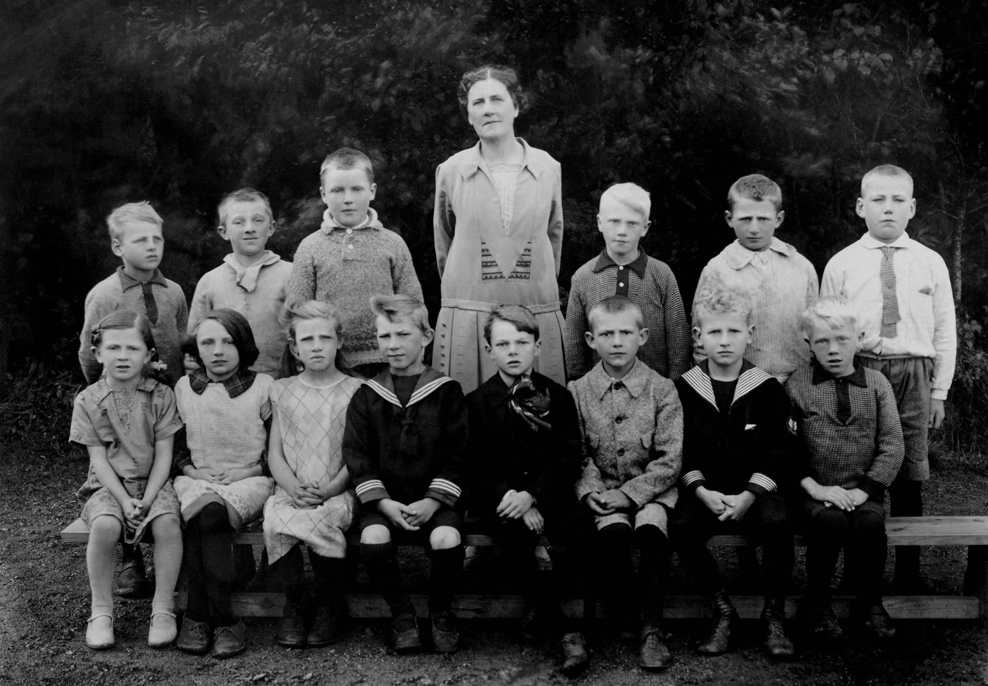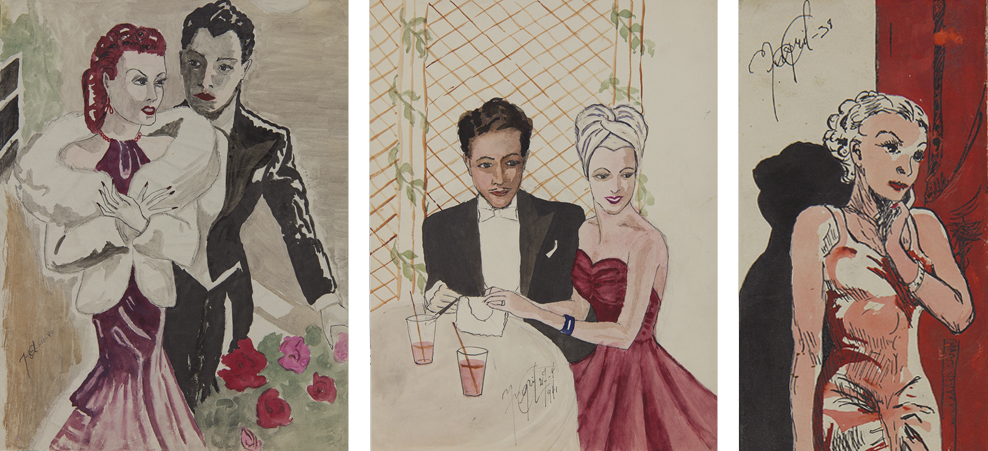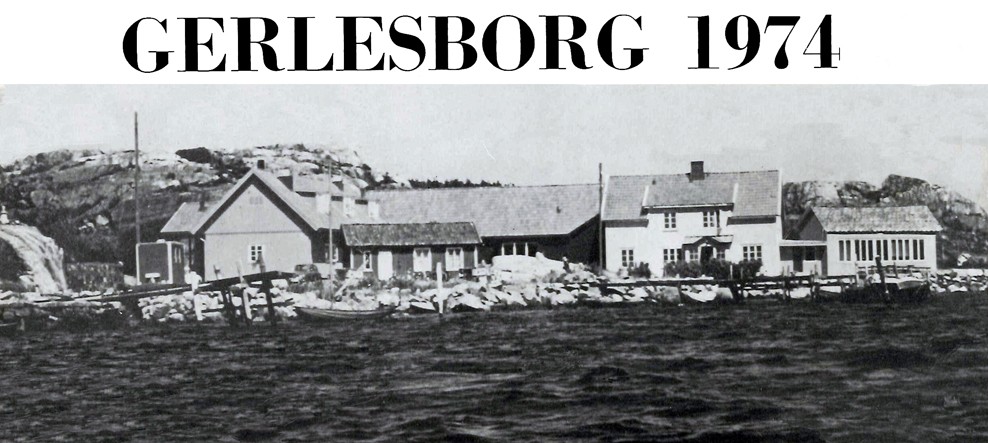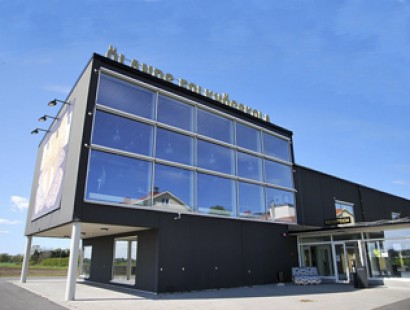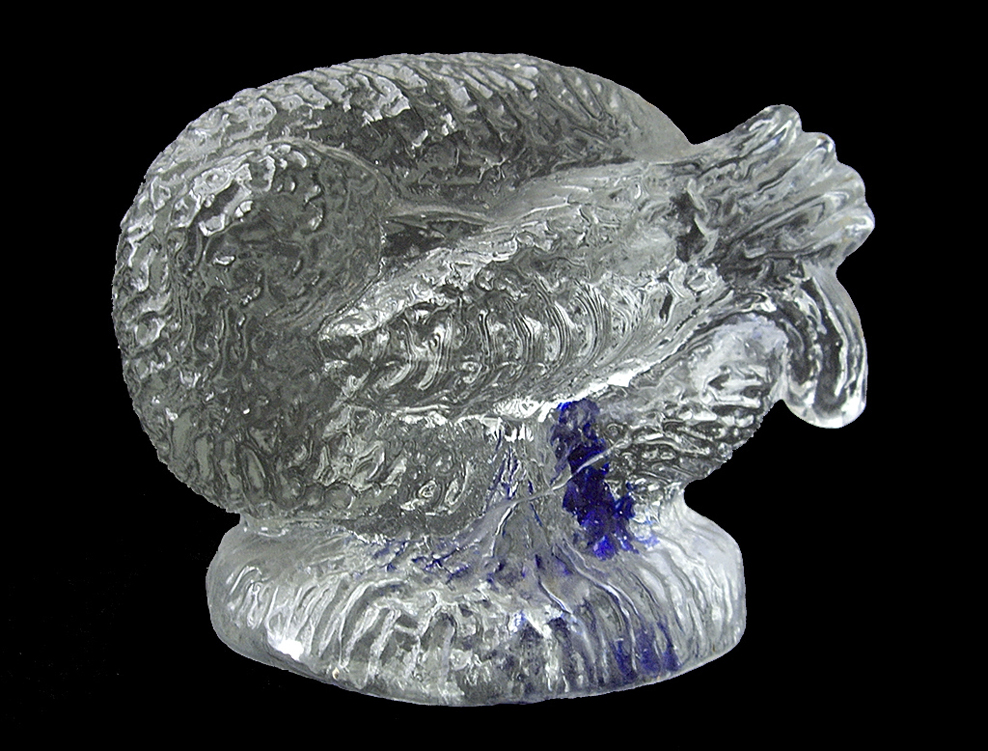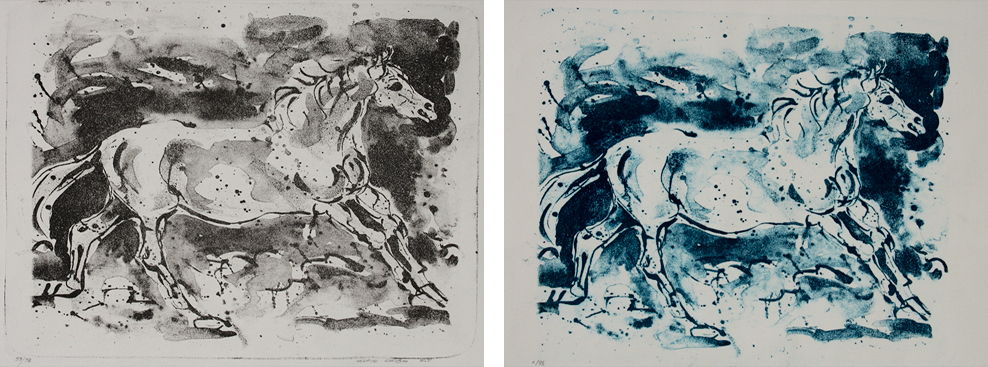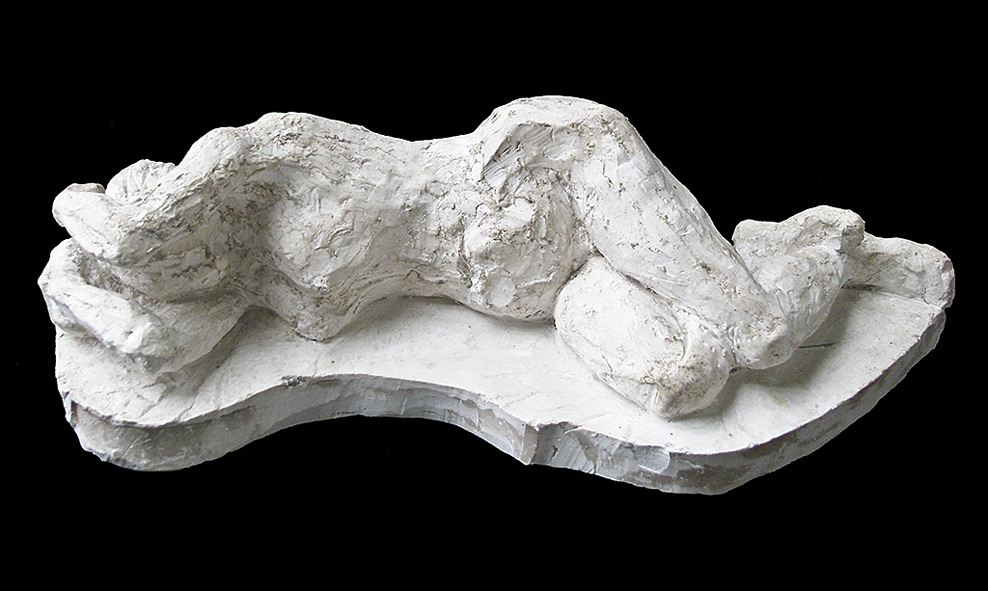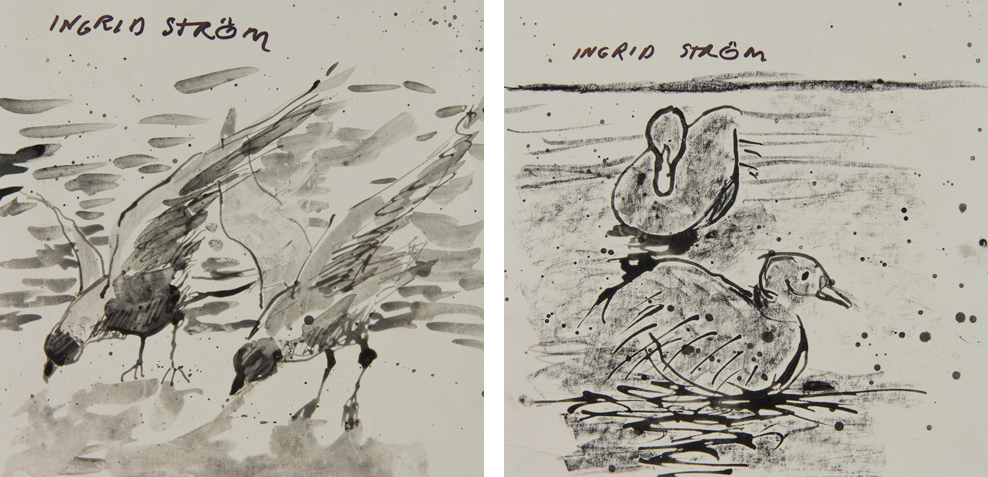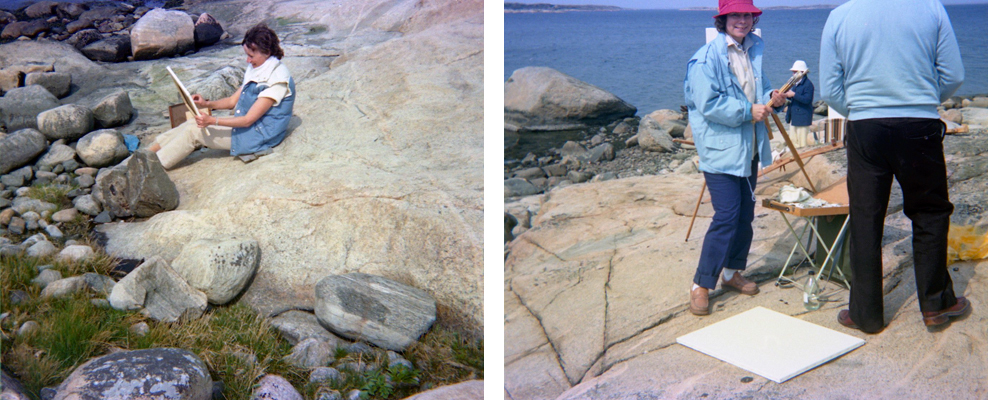| Autodidact |
| NKI-school |
| Foundation Gerlesborgsskolan |
| Ölands Folkhögskola |
| Artists Collective Workshop |
| Lithography |
| Gypsum |
| Paperlitography |
| Own Courses |
Autodidact
Basically, Ingrid Ström is Autodidact.
Autodidact:
self_teaching, to acquire expertise without receiving formal instruction from another.The word stems from the Greek autos (“self”) och didaskein (“learn”, “teach”), and thus means “self_taught”. One autodidact person is a self-taught person.
Svepetorpsskolan:
Already in elementary school (Svepetorpsskolan) was her teacher aware that Ingrid and her sisters Signe and Sofia had artistic traits that teacher tried to encourage as much as possible. A small episode that Ingrid told about, “a day in elementary school, there were crayons at the blackboard and when I tried these during a break, the result was a horse that teacher thought was so good, that it was preserved throughout the year, it was counted and written around the artwork throughout the school year”
It was signed and designed all the time at home with family Carlsson, primarily of the sisters Ingrid and Signe, Pappa Johan got continually acquire pencils, crayons and paper each time he visited Uddevalla.
Grades from the elementary school in Bokenäs, districts Göteborgs & Bohus, Ingrid Elise Carlsson born on 25 June 1921, and enrolled August 15, 1931, has at leaving certificate this day received the following grades.
Excellent with Distinction:
Christianity Knowledge, Geography, nature study, history, Gymnastics with play,
Pass with distinction:
Mother tongue, speech and reading exercises, writing and grammar, penmanship, arithmetic and geometry, Local History of Education, Employment Exercises, Crafts
Praiseworthy: Drawing
NKI-school
In the late 1930’s and early 1940’s.
The subscription course on NKI school (Nordic correspondence Institute), Ingrid Ström (formerly Carlsson) born on 25 June 1921 in Bokenäs congregation, Göteborgs & Bohus län, has been at the NKI school and engaging in correspondence studies in drawing and paintingschool and have under performed and reviewed data obtained following credentials “with distinction” in the past and completed courses in illustration Drawing, Materials, Color Harmony, Stills Painting, Landscape Painting, Figure Painting, Animal Painting, Portrait Painting.
About NKI school:
NKI school, Nordic correspondence Institute, formerly Noréns correspondence institute, founded in Malmö in 1910 and was one of the largest schools for correspondence teaching in Sweden. It merged in 1922 with Osby correspondence institutes also founded in 1910. 1937 there were courses for secondary school and from 1940 organized an engineer education where NKI-engineers graduated. The so-called NKI real schools started in 1941. The school has published a famous encyclopedia, NKI-school encyclopedia, which sold 200,000 copies, encyclopaedia published between 1937 and 1952. The NKI -school merged with Hermods 1965.
Foundation Gerlesborgsskolan
1974 – September Academy in Gerlesborg
Course time: 4 weeks starting September 1
Rector: Arne Isacsson
Deputy Head of Training: Georg Suttner
Teacher: Lizzie Olsson-Arle, Georg Suttner, Arne Isacsson and Asmund Arle
About Foundation Gerlesborgsskolan and September Academy (written in 1974):
Gerlesborgsskolan is the largest free art school and is located at Bottnafjorden in commune Tanum in Göteborgs & Bohus län. The location of Gerlesborgsskolan is ideal for outdoor studies in landscape painting, which has always been an important part of teaching. The Foundation Gerlesborgsskolan operates at two schools. Partly in in Gerlesborgsskkolan Bohuslän, Göteborgs & Bohus län, which was founded in 1944 and partly Gerlesborgsskkolan Stockholm, Stockholms län, which was started in 1958.
Principal and founder of Gerlesborgsskkolan is the driving force Arne Isacsson who for 30 years has led the school’s work, to begin with without financial help. The school’s situation was very bleak. It was threatened with closure I96I-I962. The economy improved in 1963 by the Foundation Gerlesborgsskolan formed. The school received a fixed annual payment, which later became the appropriation of the state’s cultural budget and gradually increased. The expansion is now a fact. Student Housing built, improvements carried out and new courses are planned.
Arne Isacsson is still the school principal. His goal is to create a cultural center for artists of all kinds, has now been realized. Painters, sculptors, writers, theater and TV people can now get together under one roof for the life-giving collaboration. Concerts with good musicians organized for the benefit of teachers, students and locals. concert activities is an old tradition at the school.
Many good teachers over the years have been linked to the school. Georg Suttner, deputy director of education, has for years led the school’s international operations through study tours in various countries: France, Switzerland, Provence, Greece, Holland.
The school is open during the summer. June 1st organized courses for school children. Course of color knowledge for a week in July. Painting Course in August. September Academy (August 21-September 20). For experienced students and Academie Libre in October of performers and past September academy gains.
Septemberacademy mature artists started in the early 50s and has for many years collected school’s most experienced students, and many already trained artists for a concentrated period of work in the Bohuslän landscape during its painting richest time.
Strong traditions associated with the September academy and many teachers and students have returned to it year after year. Per Lindekrantz was the first teacher and taught for five years, after which Otte Shield took over. Then came Sixten Lundbohm and then Arne Cassel and the Danish painter and theorist Ejler Bille.
In recent years, Arne Isacsson and Georg Suttner taught jointly. 1973 was the Norwegian artist Anders Kjær guest teachers. This year, Lizzie Olsson-Arle to lead the Academy in September. Georg Suttner and Arne Isacsson involved in general, common criticism and Asmund Arle is a guest teacher.
Participants September Academy 1974:
Almström Kristina (Tumba), Andersson Britt-Marie (Stockholm), Berg Ellen (Strömstad) Båmstedt Margareta (Karlstad), Elmstam Birgit, (Stockholm), Elmlund Gunilla (Rönnäng) Grunditz Marianne (Älvsjö), Gustafssson Nils-Göran (Skillingaryd), Haking Richard (Djursholm), Johansson Anna Lisa (Uddevalla), Johonson Torsten (Södertälje), de Jounge Lisa (Bromölla), Karneman Birgitta (Bandhagen), Knif Erik (Jakobstad, Finland), Larris Mona (Charlottenlund, Danmark), Larsson Lars-Ove (Uddevalla), Lindberg Ingrid (Göteborg), Lindberg Ulla (Karlstad), Lundström Ivar (Kronoby, Finland), Mowitz Barbro (Skara), Nordström Ester (Göteborg), Norlin John (Dals Långhed), Petersson Sven (Trollhättan), Rosengren Birgit (Göteborg), Rosen Barbro (Fristad), Rudman Greta ( Dals Långhed), Rutgersson Louise (Henån), Strand Margareta (Stockholm), Ström Ingrid (Mölndal), Stålbrand-Hammächer Aune ( Motala), Warg Svante (Örebro), Wennberg Göran (Vällingby), Öije Abel Karin (Upplands Väsby), Östling Anders (Tyresö), Östlund Lars (Borlänge).
Ölands Folkhögskola
About Ölands folkhögskola , Ölands Skogsby: Öland college is a college on Öland, founded 1906th It is located in Ölands Skogsby.
1975
Course in Graphic Techniques including materials science and art history
Location: Ölands Folkhögskola, Öland Skogsby
Teacher: Per Lindecrantz
Rector: Bertil Jonsson
Course time: 2 weeks (July 2 to 15)
1976
Course in Graphic Techniques including materials science and art history
Location: Ölands Folkhögskola, Öland Skogsby
Teacher: Per Lindecrantz
Rector: deputy Linette Berndtsson (Göran Palm)
Course time: 2 weeks (1-14 July)
Participants 1975:
Biuw Kersti, Järna
Eldhagen Barbro, Stockholm
Ericsson Eric, Strängnäs
Fish Gertrude, Paris 75006
Hagmarker Sven, 560 28 Lekeryd
Hultman Sven, Västervik
Håkansson Sigvard, Linghem
Knapp Franz
Salomonsson Tyra, Åmål
Ström Ingrid, Mölndal
Strominger Ingrid, USA
Artists Collective Workshop
Artists Collective Workshop (startade 1974), The Castle, Banehagsgatan 1 (old sugar mill) Gothenburg. Ingrid Member of the artists’ collective workshop, KKV between 1977-1997 consequently about 20 years where she went to different courses including in Graphics, Glass casting, Metal Enameling mm, Ingrid created many works in the above mentioned techniques on Artists Collective Workshop.
1977
Course of Copper Graphics for professional artists
Location: Collective Workshop, The Castle, Banehagsgatan 1 (old sugar mill) Gothenburg
Teacher: Rune Claesson
Course time: 2 weeks starting January 17th
The County Labour Board in Göteborgs och Bohuslän
1978
Course of Copper Graphics for professional artists
Location: Collective Workshop, The Castle, Banehagsgatan 1 (old sugar mill) Gothenburg
Teacher: Kjell-Åke Gerinder
Course time: 2 weeks starting November 20
The County Labour Board in Göteborgs och Bohuslän
1980
Course in Glass casting for professional artists
Teacher: Georg Suttner, Head of Department
Location: Collective Workshop, The Castle, Banehagsgatan 1 (old sugar mill) Gothenburg
Course time: 4 weeks, 3 November to 5 December
Valand Art Academy, University of Gothenburg
Participants Glass casting:
Knut-Yngve Dahlbäck, V:a Frölunda
Lennart Landqvist, Göteborg
Bertil Lengstrand, Brännö
Lotte Pile, Alafors
Friedrich Senger, Göteborg
Ingrid Ström, Mölndal
Anie Stålkrantz, Linköping
Britt-Marie Jern, Göteborg
Lars-Erik Anden, Göteborg
1984
Course of Metal Enameling for professional artists.
(more precisely, blasting, because enameling and painting of steel)
Location: Collective Workshop, The Castle, Banehagsgatan 1 (old sugar mill) Göteborg
Teacher: Knut Yngve Dhalbäck
Course time: 4 weeks, 20 February to 16 March
School Board in Göteborgs och Bohuslän
About Artists Collective Workshop:
The Castle, Banehagsgatan 1 (old sugar mill) Göteborg
Artists Collective Workshop Gothenburg is a nonprofit organization formed in 1974 by a group of artists in collaboration with the Municipality of Gothenburg since its inception wholeheartedly supported the activities. Now there are 11 departments that are open to professional artists and arts and crafts. Several departments are structured, fully or partially, with financial support from the Swedish Arts board and the Swedish Arts funds and others.
Through the years collective Workshop Gothenburg arranged a large number of vocational courses for artists and craftsmen in various technology areas. The courses have been arranged both in-house and in cooperation with the Employment Service Culture. KKV Gothenburg are able to organize technical courses in all disciplines.
Workshop are usually open to the public during the Culturevenings and Majornas Arttour. usally one time per year (each).
Lithography
In Lithography, Ingrid attended courses of Gösta Andersson in his Lithographic Workshop, by Kronhusbodarna in Gothenburg, She have done almost all lithographs in workshop of Gösta Andersson, Kronhusbodarna later in Pixbo after Gösta Andersson moved his workshop there, after Gösta Andersson stopped with his business Ingrid performed lithographs at Lithographic association Vulcanön Tidaholm.
Gösta Andersson on Lithography:
“In my work with Lithograph signed and I paint on a model which is available as a vision somewhere inside the head. The printing is done entirely by hand in an old printing press made over sometime at the turn of the century. As a rule, I press some thirty basic images, and by replacing paper and ink I receive a lot of variety in a small edition. Some pressure disappears while working in the trash, and from the remaining discerned those who can represent the original thought. These stamped, numbered, goods declared and signed. The usual practice of the photographic technique reproduce an already before printing completed image, or to work manually on the plate or film and then let the machine take care of the printing is not in my view lithography without offset. As opposed to my idea of what Lithography is the aim of such reproductive technology at minimal variation. With its help, accomplished three -fyrahundra or a thousand perfect machine printed images that purports to be a lithographed or even original lithographs Only the original direct-printing method from the stone by hand pressure to give the picture its special quality and charm / GÖSTA ANDERSON ”
Gypsum
Gypsumcasting technique (reinforced gypsum), Ingrid attended a private course held in Gothenburg. This is a very exciting technology, in this case, we had a woman model.
Paperlitography
The technology PaperLithography “snatched” Ingrid up somewhere along the way, which is a very interesting technique which unfortunately not used very much in Sweden, their tasks are to compared with traditional lithography on the “right way” However, there is no heavy lifting of stones, etc. “The stones are replaced” with “Paper” designed for this technology, when Ingrid began with technology PaperLithography she was at the time buying from abroad, Ingrid bought “paper” from the United States.
Own Courses
Course leader Medborgarskolan courses in oil painting and watercolors – color and form.
Ateljén Kämpegatan 38 – Spring 1982
Ateljén Kämpegatan 38 – Autumn 1986
Åbyschool – Spring 1986

